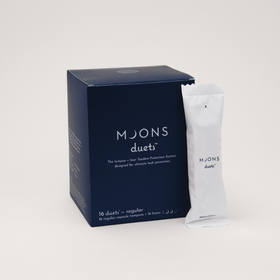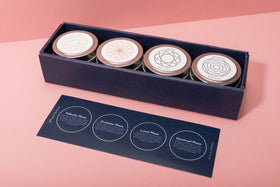The Full Menstrual Cycle: An Overview
When many of us think of our menstrual cycle we think of the “menstrual” part (and usually in a binary: we either have our period moon or we don’t) and we forget the importance of the “cycle” part. But the full cycle is where all the good “what is my body even doing” intel is! Future posts will get into details of the four elements of the full cycle, including what each feels like, what foods to eat during them, and how to optimize your life based on the natural ebb and flow of hormones, but for now we’ll provide an overview. May this help you feel more attuned to your body.
The TL;DR: In the first part of the cycle, the ovary prepares an egg for release and builds the lining of the uterus. In the second part, the uterus prepares to either accept a fertilized egg or start the cycle again.
The Follicular Phase, 5-10 days
Physically: As estrogen levels rise, the body prepares an egg for possible fertilization
Emotionally: Feelings of confidence, positivity, and social energy.
Physically: Estrogen builds until an egg is released.
Emotionally: Heightened senses, elevated moods, feelings of accomplishment.
Physically: Progesterone levels rise, then fall, causing bloating and/or breast tenderness for some.
Emotionally: Introversion, coziness and creativity, then energy swings, mood inconsistencies.
Physically: The uterine lining is eliminated and the cycle begins again. Cramping, headaches, and back pain are common.
Emotionally: Reflective moods, lower energy levels, desire for self-care.
The Full(er) Story: The full cycle is, on a global average, about 28 days, but can be a very different experience for different people. Anywhere within 24-38 days is common. Of course, cycles may change over time or vary from month to month based on external factors like stress and diet. (Just one more reason to pay attention to your body during your cycle; it can tell you what it needs!)
Follicular Phase:
Named for the sacs, or follicles, in which eggs grow, this phase begins on day 1 of your moon and lasts until ovulation. Within this phase, once menstruation is over, the uterine lining, or endometrium, builds back up again as estrogen levels rise and the body prepares to release an egg.
Ovulation:
More of an event than a phase, ovulation occurs when an egg is released from the ovary and travels to the uterus. This is triggered by rising estrogen levels and the subsequent rise in LH (leutenizing hormone). This is the window in which pregnancy is possible, and also coincides with the time that many women feel their most confident, charismatic, and passionate.
Luteal Phase:
Interestingly enough, this phase is reliably 14 days for most women all across the globe. It happens after ovulation and before your next moon, when the body prepares for possible pregnancy. Progesterone levels rise to support a health endometrium, then, assuming there is no pregnancy, fall again. This drop in progesterone is what causes the uterine lining to shed during your moon, so that the cycle can begin again.
Menstruation:
A event that usually lasts 3-7 days, your period moon occurs when your uterine lining is shed, and the hormones estrogen and progesterone are low. (For our favorite product to use during your moon, check out duets™!) The cramping, back pain, headaches and mood shifts that are common may be assuaged for some through mindful eating and movement. But no matter your experience, this is a time for replenishing your body and being gentle with yourself.
Editorial Note: The menstrual cycle is traditionally understood within the biological framework of reproduction, and while we very much acknowledge and respect that this framework may not serve everyone, we embrace it in the name of educational utility. If you’d like to engage with us more on this, we’d love to hear from you. Please email us at hello@ourmoons.com.





